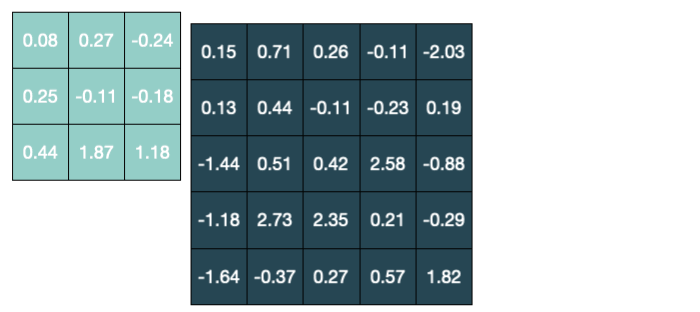Suppose you have a 2-D array, arr
import numpy as np
arr = np.array([
[0.15, 0.71, 0.26, -0.11, -2.03],
[0.13, 0.44, -0.11, -0.23, 0.19],
[-1.44, 0.51, 0.42, 2.58, -0.88],
[-1.18, 2.73, 2.35, 0.21, -0.29],
[-1.64, -0.37, 0.27, 0.57, 1.82]
])and another, smaller 2-D array, filter
filter = np.array([
[0.08, 0.27, -0.24],
[-0.25, -0.11, -0.18],
[0.44, 1.87, 1.18]
])In the context of neural networks, a convolution works by "sliding" filter over arr in row major order (left to right, top to bottom), taking the dot product between filter and the portion of arr it covers at each step.

The result of all these dot products is the following 3x3 array.
[[ 0.9 4.15 4.47]
[ 7.74 5.27 0.74]
[-1.6 -0.43 3.72]]Now suppose arr is the following 33x33x3 array.
import numpy as np
rng = np.random.default_rng(123)
arr = rng.normal(size=(33,33,3)).round(2)
print(arr)
# [
# [[-0.99 -0.37 1.29]
# [ 0.19 0.92 0.58]
# [-0.64 0.54 -0.32]
# ...
# [ 1.23 0.15 0.48]
# [-0.15 1.32 -1.22]
# [-0.3 -1.17 0.83]]
#
# [[ 0.85 -0.52 1.66]
# [-0.3 -1.38 -0.28]
# [ 0.36 -0.23 2.27]
# ...
# [ 1.52 0.49 0.7 ]
# [ 0.85 -0.91 0.12]
# [ 0.15 -0.16 -1.09]]
#
# ...
#
# [[-0.38 -0.45 1. ]
# [-0.58 2.18 0.36]
# [-0.44 -2.77 0.82]
# ...
# [-1.58 -0.5 -0.52]
# [-0.86 -0.54 -0.26]
# [ 0.23 0.81 -0.4 ]]
#
# [[-1.98 -0.22 -0.79]
# [-0.01 -1.47 -0.83]
# [-0.87 0.3 -0.82]
# ...
# [ 1.42 0.7 -0.75]
# [-0.81 1.68 -0.82]
# [-0.93 0.28 -1.61]]
# ]And let filter be the following 5x5x3 array.
filter = rng.normal(size=(5,5,3)).round(2)
print(filter)
# [
# [[-1.47 0.74 0.58]
# [ 0.46 2.37 0.79]
# [ 1.15 -1.11 -0.29]
# [-0.98 0.29 0.44]
# [-0.44 -0.03 0.69]]
#
# [[ 0.34 0.67 -0.11]
# [-0.71 -1. -0.88]
# [ 0.61 0.49 -0.27]
# [ 0.12 -1.56 0.11]
# [ 0.32 -0.98 0.46]]
#
# [[-1.03 0.58 0.08]
# [ 0.89 0.86 1.49]
# [-0.4 0.86 -0.29]
# [ 0.07 -0.09 -0.87]
# [ 0.2 1.22 -0.27]]
#
# [[ 1.1 -2.61 1.64]
# [-1.15 0.47 1.44]
# [-1.45 0.39 1.37]
# [ 0.13 -0.1 0.04]
# [ 0.27 0.57 0.57]]
#
# [[-0.61 -0.41 0.93]
# [ 1.47 -0.07 -0.29]
# [ 0.49 1.02 0.2 ]
# [ 0.16 0.95 0.52]
# [ 1.11 0.13 -0.17]]
# ]Using strides of length two , calculate the convolution between these arrays. (The result should have shape 15x15.)

